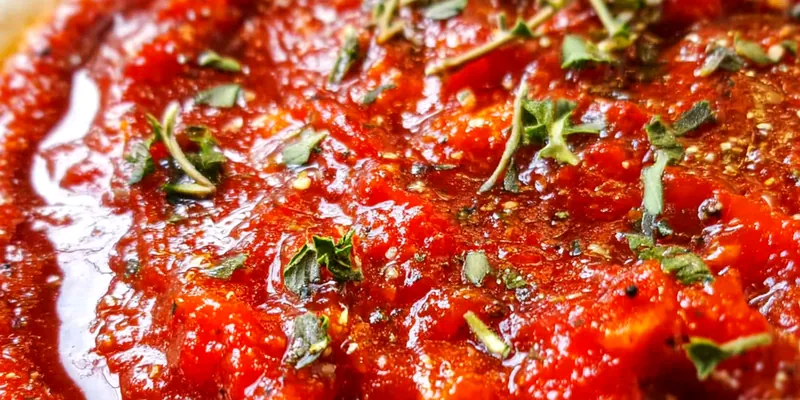Best Homemade Pizza Sauce
Rich and flavorful homemade pizza sauce made with quality tomatoes, herbs, and garlic. Perfect consistency and authentic taste for all your pizza creations.

The Art of Perfect Pizza Sauce
Creating exceptional pizza sauce starts with understanding that less is more. The best pizza sauces let the natural sweetness and acidity of quality tomatoes shine through, enhanced but not masked by carefully chosen herbs and aromatics.
The key to perfect consistency lies in gentle cooking and proper reduction. The sauce should be thick enough to stay put on the dough without making it soggy, yet spreadable enough to cover evenly. This balance comes from controlled simmering and the right tomato-to-liquid ratio.
💡 Professional Tip
Always taste and adjust seasoning at the end of cooking. The flavors concentrate as the sauce reduces, so what tastes balanced at the beginning may need fine-tuning once finished.
Frequently Asked Questions
This recipe creates a cooked sauce that's ready to use. Some prefer uncooked sauce, but cooking develops deeper flavors and better consistency for most pizza styles.
Yes, but San Marzano tomatoes provide superior flavor and lower acidity. If using regular tomatoes, choose whole tomatoes over crushed for better texture control.
Store in the refrigerator for up to 1 week or freeze for up to 6 months. The flavors actually improve after a day as they meld together.
Continue simmering to reduce moisture, or strain excess liquid. Some tomato brands have more water content, so cooking time may vary.
Sugar balances the acidity of tomatoes, but you can omit it or substitute with grated carrot for natural sweetness. Taste and adjust accordingly.
Use the back of a spoon in circular motions, leaving a 1-inch border for the crust. Less is more - too much sauce makes pizza soggy.
A splash of red wine can add depth. Add it after the garlic and cook for 2-3 minutes to evaporate the alcohol before adding tomatoes.
Use about 1/4 to 1/3 cup sauce per 12-inch pizza. This recipe makes enough sauce for 6-8 pizzas, perfect for meal prep or freezing portions.
Recipe Troubleshooting Guide
Sauce Too Acidic
Problem: Pizza sauce tastes too tart or acidic
Solution: Add a pinch more sugar or a small piece of carrot while simmering. Some tomato brands are naturally more acidic than others.
Sauce Too Sweet
Problem: Pizza sauce is overly sweet
Solution: Balance with a splash of lemon juice or red wine vinegar. Add gradually and taste as you go.
Sauce Too Thin
Problem: Sauce is too watery and won't stay on pizza
Prevention: Continue simmering uncovered to reduce moisture, or add a tablespoon of tomato paste to thicken naturally.
Sauce Too Thick
Problem: Sauce is too thick to spread easily
Recovery: Thin with reserved tomato juice, water, or a splash of olive oil. Add liquid gradually until desired consistency is reached.
Bland Flavor
Problem: Sauce lacks depth and flavor complexity
Prevention: Increase garlic, add more herbs, or simmer longer to concentrate flavors. A Parmesan rind adds umami depth.
Flavor Balance Issues
Too Sweet: Add lemon juice, red wine vinegar, or more red pepper flakes
Too Salty: Add sugar, more tomatoes, or dilute with water
Bland: Increase garlic, herbs, salt, or add a splash of good olive oil

Choosing the Right Tomatoes
The foundation of exceptional pizza sauce lies in selecting the right tomatoes. San Marzano tomatoes are prized for their sweet flavor, low acidity, and meaty texture that breaks down beautifully when crushed by hand.
If San Marzano tomatoes aren't available, look for whole canned tomatoes with minimal additives. Avoid pre-crushed or sauce varieties, as they often contain thickeners and preservatives that can affect the final flavor and texture of your sauce.
Essential Ingredient Notes
- San Marzano Tomatoes: Look for DOP certification for authentic San Marzano tomatoes. They're sweeter and less acidic than regular tomatoes, creating superior sauce.
- Quality Olive Oil: Use extra virgin olive oil for the best flavor. The oil carries the garlic and herb flavors throughout the sauce and adds richness.
- Fresh vs. Dried Herbs: Dried herbs work better for pizza sauce as they won't burn during baking. Save fresh herbs for finishing or garnishing the completed pizza.

Achieving Perfect Consistency
The ideal pizza sauce consistency is thick enough to stay in place during baking but smooth enough to spread evenly. This balance comes from proper reduction through gentle simmering and understanding how different tomato varieties behave when cooked.
Hand-crushing the tomatoes creates the perfect texture - chunky enough for rustic appeal but smooth enough for even coverage. Avoid using a blender or food processor, which can make the sauce too smooth and affect the final mouthfeel.
The Hand-Crush Method
Crush tomatoes by hand to control texture perfectly. Squeeze each tomato through your fingers, removing any tough stem pieces while maintaining some chunky character.
Best Homemade Pizza Sauce
📋 Ingredients
Base Ingredients
- 5ml dried oreganoEssential pizza herb
- 5ml dried basilClassic Italian flavor
- 2ml dried thymeAdds earthy depth
- 2ml red pepper flakesFor gentle heat
- 5ml saltEnhances all flavors
- 5ml sugarBalances acidity
- 30g fresh basil, choppedFor finishing freshness
Seasonings & Herbs
- 800g can whole San Marzano tomatoesBest quality for superior flavor
- 30ml extra virgin olive oilCarries flavors and adds richness
- 4 cloves garlic, mincedFresh garlic for best flavor
- 15ml tomato pasteConcentrates tomato flavor
- 15ml fresh lemon juiceBrightens the finished sauce
- Optional: 1 bay leafAdds subtle herbal complexity
- Optional: Parmesan rindFor umami depth
Instructions
Prepare Tomatoes
Drain San Marzano tomatoes and crush them by hand into chunky pieces, removing any tough stem pieces. Reserve the juice for thinning if needed.
Sauté Aromatics
Heat olive oil in a large saucepan over medium heat. Add minced garlic and red pepper flakes, cooking for 1-2 minutes until fragrant but not browned.
Add Tomato Paste
Stir in tomato paste and cook for 1 minute, stirring constantly to develop deeper flavor and prevent burning.
Build the Sauce
Add crushed tomatoes, oregano, basil, thyme, salt, pepper, and sugar. Add bay leaf and Parmesan rind if using. Bring to a gentle simmer.
Simmer and Finish
Reduce heat to low and simmer for 15-20 minutes, stirring occasionally, until sauce thickens to desired consistency. Remove bay leaf and Parmesan rind. Stir in lemon juice and fresh basil. Taste and adjust seasoning.
Recipe Notes & Tips
Storage
Store in the refrigerator for up to 1 week or freeze in portions for up to 6 months. The sauce actually improves in flavor after resting for a day.
Usage Tips
Use 1/4 to 1/3 cup sauce per 12-inch pizza. Spread thinly, leaving a 1-inch border for the crust. Less sauce prevents soggy pizza.
Variations
Add roasted garlic for deeper flavor, white wine for complexity, or fresh herbs like rosemary or sage. A splash of balsamic vinegar adds subtle sweetness and depth.
